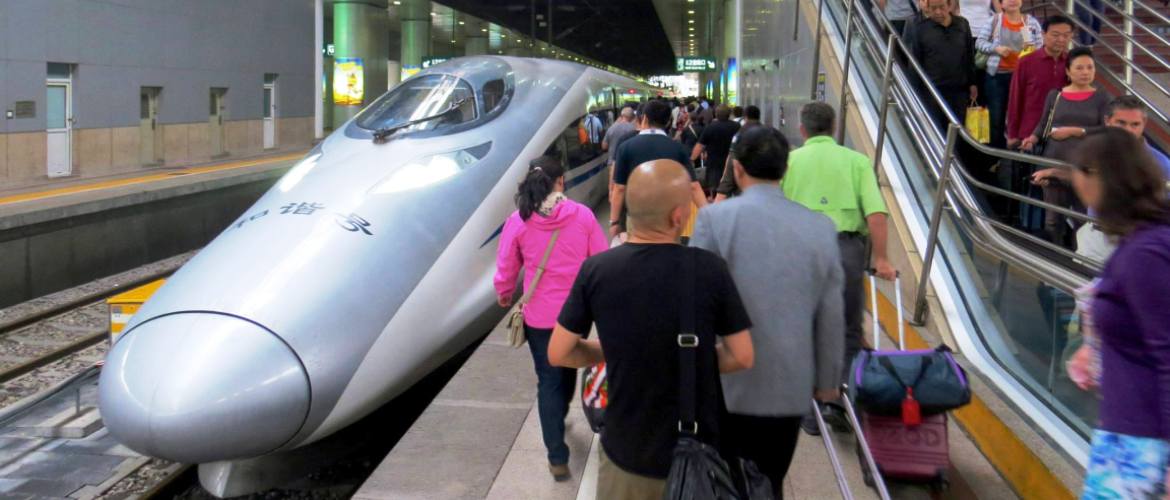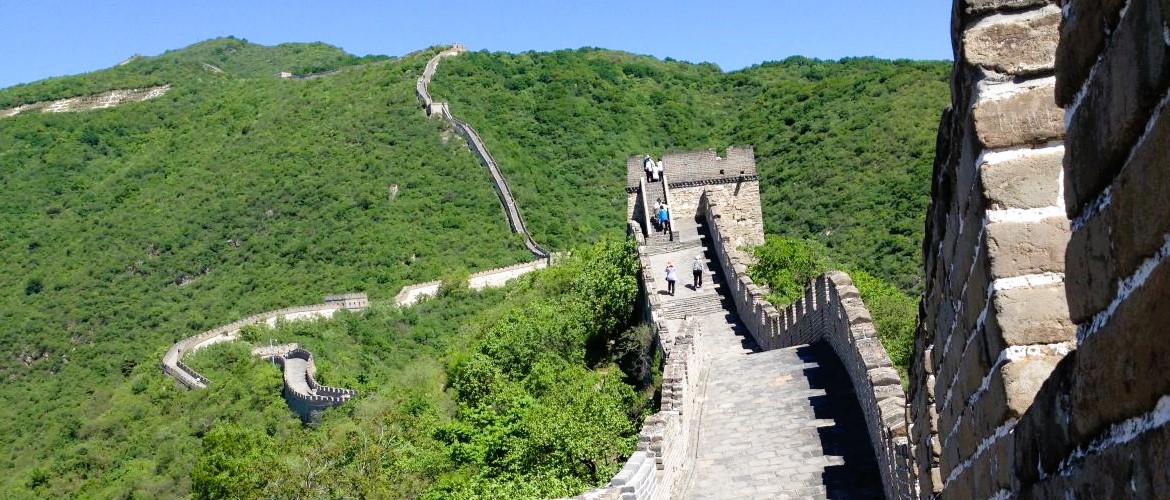Shanghai – Suzhou – Tongli – Qufu – Beijing
This luxury small-group China tour by bullet train strings together a good collection of UNESCO World Heritage Sites. Highlights include classic gardens in Suzhou, Temple of Confucius in Qufu, the Great Wall and Forbidden City in Beijing.
Important Features
- Small group size – average 15, maximum 20.
- Expert guides handpicked by company owners.
- Inter-city travel by high-speed train.
- No annoying forced shopping stops.
- Quality meals at non-tourist restaurants.
- Unlimited supply of bottled water during group activities.
- Complimentary Wi-Fi in all hotels.
- Great Wall visit at Mutianyu including cable car rides.
OPTIONS AVAILABLE
- 2-day pre-tour Yellow Mountain Hiking extension
- Peking Opera show with dinner in Beijing subject to availability
Meal Code: B = breakfast / L = lunch / D = dinner
Day 1/Thu: Departing for Shanghai
Depart from a city of your choice and lose a day upon crossing the International Date Line.
Day 2/Fri: Arrival in Shanghai
Meet the driver on arrival for transfer to the hotel. You’ll have the balance of the day at leisure. The guide will get in touch with you tonight.
Day 3/Sat: Shanghai (B/L/D)
With a population of 24.9 million (2021), Shanghai is China’s biggest city, which delights the visitor with its futuristic skyline and historical landmarks.
Following the tour orientation we visit Jade Buddha Temple located in an old neighbourhood, the famous waterfront promenade known as the Bund, and the Yu Garden in the old town centre. We wrap up the day with a drive through the glitzy financial district of Lujiazui on the opposite side of the Bund across Huangpu River.
Day 4/Sun: Shanghai (B)
Free day to explore on your own. We recommend Shanghai Museum and the Urban Planning Exhibition Center nearby. Shanghai Museum is frequently cited by visitors as one of the best of its kind in China, it is also a great place to explore on your own.
Day 5/Mon: Shanghai – Suzhou (B/L)
After a leisurely breakfast we drive 85 km to Suzhou. Ancient Suzhou is most famous for its gardens, canals and silk industry. In the late 13th century a Venetian named Marco Polo visited Suzhou and was very impressed by what he saw. He vividly described the prosperous silk industry and dubbed Suzhou “Venice of the East” due to the small waterways crisscrossing the city.
Our full-day schedule takes in historic Tiger Hill, Humble Administrator’s Garden, Suzhou Museum (designed by I. M. Pei), North Pagoda and a short canal cruise. Those interested in shopping can ask to be dropped off at the Silk Embroidery Research Institute or a filature (silk reeling mill) on the way back to the hotel.
Day 6/Tue: Suzhou – Tongli – Suzhou (B/L)
We set off for Tongli following breakfast. Located 25 km south of Suzhou, ancient Tongli is renowned for its canal system intersecting the town. After lunch we return to Suzhou and have the remainder of the day at leisure.
Day 7/Wed: Suzhou – Qufu (B/L/D)
This morning we board the bullet train for Qufu (3 ½ hours). Qufu is the hometown of Confucius (551-479 BCE), who lived around the same time as Siddhartha Gautama (the Buddha) and Cyrus the Great of Persia. His teachings collectively known as Confucianism have played and continue to play a vital role in the evolution of Chinese civilization.
In the afternoon we tour the massive Confucius Temple which features a series of impressive gateways, clusters of twisted pines and cypresses, inscribed steles and tortoise tablets recording ancient events.
Day 8/Thu: Qufu (B/L)
We begin our sightseeing this morning at the mansion once inhabited by the descendants of Confucius. We then proceed to Confucius Forest – the last resting place of Confucius and a cemetery for his descendants. The cemetery, the residence and the temple together form the UNESCO designated World Heritage Site in Qufu. If time allows, we will visit a village nearby.
Day 9/Fri: Qufu – Beijing (B/L)
We spend the morning exploring the small town on our own. After lunch we ride the bullet train to Beijing (80 minutes) and transfer to the hotel on arrival.
The capital of China, Beijing is a world-class cultural and educational centre with a population close to 22 million, ranking it China’s second biggest city behind Shanghai. Beijing is renowned for its opulent palaces, temples, and huge stone walls and gates – treasures that make it the most popular tourist city in China by the number of visitors it receives every year.
Afternoon sightseeing in Beijing takes in Lama Temple and Guozijian (imperial academy). Lama Temple, commonly known as Yonghe Temple among locals, was built in 1694 as residence of Prince Yong (Yinzhen), one of the sons of Emperor Kangxi. After Prince Yong ascended the throne as Emperor Yongzheng in 1722, half of his former residence was turned into a lamasery – a monastery for monks of Tibetan Buddhism. Guozijian was the highest institute of learning in China’s traditional educational system during the Yuan, Ming and Qing dynasties. One of its main functions was assisting the imperial court in administering national examinations.
Day 10/Sat: Beijing (B/L/D)
We begin today with a visit to the Forbidden City. Officially known as the Palace Museum, the Forbidden City was the place where the emperors of the Ming (1368-1644) and Qing (1644-1912) Dynasties lived and carried out their administration. Construction of the Forbidden City took 14 years (1406-1420) to complete. The complex consists of 980 buildings and covers 72 hectares or 180 acres. Though the Qing Dynasty was overthrown in 1912, the royal family was allowed to continue to live in the Forbidden City till 1924, when the last emperor, Pu Yi, was driven out of the imperial palace. Declared a World Heritage Site by UNESCO in 1987, this is the largest collection of preserved ancient wooden structures in the world.
Next up is Tian’anmen Square. Located in the heart of Beijing, the square measures 880 metres from north to south and 500 meters from east to west. Said to be the largest public plaza in the world, Tian’anmen Square has the capacity to hold one million people. The imposing Tian’anmen Tower sits at the north end of the square while the Monument to the People’s Heroes dominates the centre. The square is flanked by The Great Hall of the People (west) and the National Museum (east). Chairman Mao’s Mausoleum and Qianmen (Front Gate) are located in the south of the square. One of the top 16 tourist attractions in Beijing, Tian’anmen Square is also the witness of the Chinese people’s great struggles for democracy and personal freedom since 1919.
Afternoon sightseeing takes place at the Temple of Heaven, another UNESCO World Heritage Site. Situated in southeastern Beijing the Temple of Heaven is China’s largest extant sacrificial temple where, during the Ming and Qing Dynasties, the emperors conducted the elaborate and most exalted sacrifices addressed to “the Supreme Ruler of the Universe.” Construction of the temple started in 1406, during the reign of the Ming Emperor Yongle, and took 14 years to complete. The temple was expanded under the Qing emperors Qianlong (1736-1796) and Jiaqing (1796-1820). Occupying 2.73 square kilometres (roughly 1,700 by 1,600 metres), the area of the Temple of Heaven is more than twice that of the Forbidden City.
The famous Hongqiao Pearl Market, the largest pearl market in the world, is right across the street from the Temple of Heaven. Recommended by numerous guidebooks for freshwater pearls, Hongqiao teems with domestic and international shoppers. If you are interested, please ask the guide to drop you off there. However, you’ll need to get back to the hotel by taxi, which costs less than 10 US dollars.
Today we enjoy a delicious dinner at a popular Peking Roast Duck restaurant. Peking Roast Duck is a famous Beijing dish prized for the thin and crispy skin with authentic versions serving mostly the skin and little meat, sliced in front of the diners. The meat is wrapped in a thin layer of pancake (Chinese tortilla) together with shredded scallion, cucumber, and a sweet and salty sauce made of wheat flour. Condiments may also include pickled garlic and white sugar.
Day 11/Sun: Beijing (B/L)
After an early breakfast we embark on a full-day excursion to the legendary Great Wall at Mutianyu, 75 km northeast of the city.
Zigzagging over 6,000 kilometres from east to west along undulating mountains, the Great Wall was built to hold off tribal invaders from the north. As history shows, the Wall failed the Chinese rulers miserably, especially in the case of Kublai Khan whose cavalrymen swept across China from the Mongolian steppe, thus the beginning of the Yuan Dynasty (1279-1368).
Construction of the earliest sections of the Wall started in the 7th century BCE. A major renovation started with the founding of the Ming Dynasty in 1368 and took 200 years to complete. The wall we see today in Beijing is almost exactly the result of this effort.
Day 12/Mon: Beijing (B/L)
We begin our sightseeing today with a visit to a traditional hutong neighbourhood. Hutong refers to an ancient alleyway with siheyuan or ”4-sided courtyard house” on both sides. The name hutong dates back to the Yuan Dynasty (1279 – 1368 CE). According to some experts, the word originated from the Mongolian language, in which it is pronounced as hottog and means “well.” In ancient times, people tended to gather and live around wells. Therefore, the original meaning of hutong should be “a place where people live around”.
Next on our schedule is the Summer Palace, a well preserved UNESCO World Cultural Heritage Site. The imperial resort was first named Garden of Clear Ripples, which was burnt down by the allied forces of Great Britain and France in 1860 at the end of the Second Opium War (often referred to as the Arrow War by the British). Reconstruction started 25 years later and was completed in 1895 when the name was changed to Yi He Yuan (Garden of Good Health and Harmony). The design gives prominence to Longevity Hill, as well as Kunming Lake south of the hill. The sprawling complex covers an area of 290 hectares and the buildings inside consist of over 3,000 bays.
After lunch we spend the balance of the day exploring on our own.
Day 13/Tue: Returning Home (B)
Your tour ends this morning. Transfer to the airport any time for return flight. Guests flying back to North America will regain a day upon crossing the International Date Line, thus arriving home the same day as departing from Beijing.
| City | Nights | Hotel | Category |
| Shanghai | 3 | Amara Signature Shanghai | luxury |
| Suzhou | 2 | Pan Pacific Suzhou | luxury |
| Qufu | 2 | Shangri-La Hotel | luxury |
| Beijing | 4 | New Otani Chang Fu Gong | luxury |
Dates and Prices
discount available
Prices are per person based on double occupancy. See Terms & Conditions for cancellation penalty.
| Depart (Thu) |
Return (Tue) |
Land Only* CA$/US$ |
Single Supplement CA$/US$ |
| 2025 | |||
| 06-Mar | 18-Mar | $3,220/$2,300 | $1,120/$800 |
| 27-Mar | 08-Apr | $3,360/$2,400 | $1,190/$850 |
| 03-Apr | 15-Apr | $3,570/$2,550 | $1,260/$900 |
| 10-Apr | 22-Apr | $3,640/$2,600 | $1,260/$900 |
| 17-Apr | 29-Apr | $3,710/$2,650 | $1,260/$900 |
| 08-May | 20-May | $3,710/$2,650 | $1,260/$900 |
| 15-May | 27-May | $3,710/$2,650 | $1,260/$900 |
| 22-May | 03-Jun | $3,360/$2,400 | $1,190/$850 |
| 29-May | 10-Jun | $3,220/$2,300 | $1,190/$850 |
| 05-Jun | 17-Jun | $3,220/$2,300 | $1,190/$850 |
| 12-Jun | 24-Jun | $3,220/$2,300 | $1,190/$850 |
| 19-Jun | 01-Jul | $3,220/$2,300 | $1,190/$850 |
| 26-Jun | 08-Jul | $3,290/$2,350 | $1,190/$850 |
| 31-Jul | 12-Aug | $3,360/$2,400 | $1,190/$850 |
| 07-Aug | 19-Aug | $3,360/$2,400 | $1,190/$850 |
| 14-Aug | 26-Aug | $3,360/$2,400 | $1,190/$850 |
| 21-Aug | 02-Sep | $3,290/$2,350 | $1,190/$850 |
| 28-Aug | 09-Sep | $3,290/$2,350 | $1,190/$850 |
| 04-Sep | 16-Sep | $3,570/$2,550 | $1,190/$850 |
| 11-Sep | 23-Sep | $3,710/$2,650 | $1,260/$900 |
| 18-Sep | 30-Sep | $3,710/$2,650 | $1,260/$900 |
| 09-Oct | 21-Oct | $3,850/$2,750 | $1,260/$900 |
| 16-Oct | 28-Oct | $3,850/$2,750 | $1,260/$900 |
| 23-Oct | 04-Nov | $3,850/$2,750 | $1,260/$900 |
| 30-Oct | 11-Nov | $3,710/$2,650 | $1,190/$850 |
| 06-Nov | 18-Nov | $3,570/$2,550 | $1,190/$850 |
| 13-Nov | 25-Nov | $3,360/$2,400 | $1,190/$850 |
| 20-Nov | 02-Dec | $3,360/$2,400 | $1,190/$850 |
* Land Only price excludes international airfare. Please contact us for a fare quote.
|
What the tour price includes:
|
What the tour price excludes:
See Terms & Conditions for more information. |




